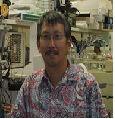Day 1 :
Keynote Forum
Fang Xie
Imperial College London
United Kingdom
Keynote: Nanoscale Engineering of Metal Nanostructures for Early Diagnosis of Cancer
Time : 10:00-10:30

Biography:
Fang Xie was awarded her PhD in 2008 and was appointed as a Lecturer at Imperial College London in 2013. She has expertise in metal, semiconducting, and oxide nanomaterials synthesis and their applications in energy and life sciences. Her current research interests include plasmonic nanostructures for biosensing and bioimaging. She has over 50 publications (h-index = 15) including 5 patents.
Abstract:
Early diagnosis plays an increasingly significant role in current clinical drive. Detection, identification, and quantification of low abundance biomarker proteins form a promising basis for early clinical diagnosis and offer a range of important medical benefits. Amplification of light from NIR fluorophores by coupling to metal nanostructures, i.e. Metal Induced Fluorescence Enhancement (MIFE), represents a promising strategy for dramatically improving the detection and quantification of low abundance biomarker proteins, and potentially increase already sensitive fluorescence based detection by up to three orders of magnitude. The amplification of the fluorescence system is based on interaction of the excited fluorophores with the surface plasmon resonance in metallic nanostructures. The enhanced fluorescence intensity due to the existence of metal nanostructures makes it possible to detect much lower levers of biomarkers tagged with fluorescence molecules either in sensing format or for tissue imaging. The first part of my talk will focus on some recent developments of plasmonic metal nanostructures by both “top-down” and “bottom up” methods. I will then discuss the prepared plasmonic nanostructures in the applications of biosensing.
Keynote Forum
Gaston Hui Bon Hoa
National Instituteof Health and Medical Research, France
Keynote: Combined use of NIR Raman spectroscopy and Baro-Bioreactor to correlate the impact of extreme physico-chemical environments (D2O solvent, high temperature and high pressure) on the viroids structure and function
Time : 09:30-10:00

Biography:
Gaston Hui Bon Hoa has completed his PhD in 1974 from the University of Paris XI and obtained his positions in I.N.S.E.R.M. since 1975. He is an Emeritus Director of Research since 2000 in the Hospital Bicêtre Center, France. His expertise is focus on the studies of cryo-enzymology and enzyme intermediates (1978-1980), cytochrome P450’s structure and function (1981-1992), pressure-induced protein’s stability, compressibility and dynamics (1992-2015). In 2012, he started the study of viroids structure, conformation and function. He has published more than 150 papers in reputed international journals and has been serving as an Editorial Board Member of repute.
Abstract:
Viroids are the smallest non encapsidated RNA plant pathogens. They are able to infect dramatically a broad range of plants. The Avsunviroidae such as Avocado sunblotch viroid minus strand (ASBVd(-)) is a compact rod-like circular RNA which possessa catalytic hammerhead ribozyme (HHR) motif responsible for crucial cleavage step during viroid replication. To date little is known regarding the structure and conformation of ASBVd viroids, the catalytic role of Mg2+ and the ways by which such viroids induces diseases. This prompts us to develop a NIR Raman spectroscopy which is a sensitive technique for monitoring RNA’s molecular structure and a Baro-bioreactor designed to allow rapid injections of effectors and sampling out of biomolecular products under pressure for activity studies. ASBVd(-) viroids exhibit a typical A-type RNA conformation with ordered double helical content and a C3’-endo/anti sugar pucker configuration. Deuteration and temperature perturbed differently the RNA’s phosphodiester conformation. Mg2+-activated self-cleavage does not significantly alter the secondary RNA’s structure but noticeable Raman frequency downshifts were observedsuggesting that several phosphodioxy structure, internal loops and hairpins of the cleaved viroids have changed. RNA self-cleavage activity decreased upon deuteration indicating some accessibility of H-bonding network anda rigidity of RNA’s structure. A pressure-induced decrease of the RNA’s self-cleavage pH profile is interpreted as a consequence of some compaction of the structure and a release of catalytic water molecules during catalysis.All these data will constitute the basis for further studies of the interactions of such viroids with therapeutic agents and cell membranes.
- Track 5: Biotechnology and Genetic engineering
Track 8: Cell, Micro and Molecular Biology
Location: Juniper Tree Room

Chair
Yong soo Kim
University of Hawaii, USA

Co-Chair
Nipunjot Kaur Soni-Bains
Khalsa College, India
Session Introduction
Yong soo Kim
University of Hawaii, USA
Title: Production of bioactive myostain propeptide of various animal species in E. coli.
Time : 10:50-11:10

Biography:
Yong Soo Kim has completed his PhD in the field of Animal Physiology from the University of California, Davis and Postdoctoral studies from Melbourne University. He is a Professor at the Department of Human Nutrition, Food and Animal Science, University of Hawaii, Manoa. His research area involved muscle growth and development and meat science and research activities in muscle biology area have focused on understanding the mechanisms involved in the regulation of muscle growth and development and improving animal growth rate and carcass composition.
Abstract:
Myostatin (MSTN) is a potent negative regulator of skeletal muscle growth in various animal species, thus there have been attempts to develop MSTN-inhibitory strategies to improve skeletal muscle growth in meat-producing animals as well as to treat muscle-wasting conditions in humans. MSTN propeptide (MSTNPro), the N-terminal part of unprocessed MSTN suppresses MSTN bioactivity by prevention of MSTN binding to its membrane receptor suggesting that MSTNPro is a potential candidate molecule to be used to suppress MSTN activity. To examine the potential of MSTNPro as an agent to improve skeletal muscle growth of meat producing animals in vivo, a large quantity of MSTNPro must be available. Since E. coli remains the most cost-effect system in high-yield production of recombinant proteins, we have attempted to produce bioactive MSTNPro in E. coli. Our first attempt demonstrated that rainbow trout MSTNPro was expressed in soluble forms using maltose binding protein as an N-terminal fusion partner. Affinity purified rainbow trout MSTNPro demonstrated MSTN-inhibitory activity in an in vitro assay system and the potency was not different from that of commercial mouse MSTNPro produced in a eukaryotic system. In subsequent studies, bioactive MSTNPro of chicken, pig and mouse were produced using the same E. coli system. Interestingly, MSTN-inhibitory potencies were different among MSTNPros from different animal species. The ability to produce MSTNPro in a cost effective E. coli system is expected to make it easy to investigate the potentials of MSTNPro as a pharmaceutical agent to improve skeletal muscle growth of meat producing animals.
Nipunjot Kaur Soni-Bains
Khalsa College, India
Title: Control of protease activity in S. pombe using gene silencing approach
Time : 11:10-11:30

Biography:
Abstract:
Amongst yeasts, the fission yeast Schizosaccharomyces pombe, is an attractive host model for high-level protein production and functional analysis of eukaryotic proteins as it shares many molecular, genetic and biochemical features with higher eukaryotes such as plants and animals, and is distinguishable from other yeasts through its ability to proliferate by fission rather than budding. Furthermore, S. pombe has a developed Golgi apparatus and galactosy ltransferase that is not found in other yeast cells. However, one of the major hurdles in efficient production and purification of heterologous proteins from S. pombe is proteolytic degradation of the recombinant gene products by host-specific proteases. The problem becomes significant when the recombinant protein under production, is secretory and proteolytically sensitive in nature. Present study aims at controlling the protease activity by gene silencing approach. RNA silencing is an evolutionarily conserved gene regulatory mechanism with many species-specific variations by which double stranded RNA (dsRNA) causes sequence-specific degradation of mRNA sequences. It has become a powerful tool for genetic analyses and is likely to become a potent therapeutic approach for gene silencing. A Protease silencing cassette was designed to impede the protease enzyme post trascriptionally. Since all proteases do not attack all proteins, only protein specific protease is sought to be silenced as a test case in this study. Human Parathyroid hormone having a chain of 115 AAs was selected as model protein and the silencing of protease responsible for its degradation was studied as a test case.
Risheng Wang
Missouri University of Science and Technology, USA
Title: The Fabrication of DNA Nanostructures and Their Applications in Bionanotechnology
Time : 11:30-11:50

Biography:
Risheng Wang has completed her PhD in 2010 from New York University. She then joined, as Postdoctoral research associate, the Department of Chemistry and Applied Physics and Applied Mathematics (APAM) at Columbia University. After which she became an Assistant Professor at Chemistry department of Missouri University of Science and Technology. She has published a series of papers in reputed journals.
Abstract:
Deoxyribonucleic acid (DNA), as you may very well know, is the carrier of generic information in living cells, which can replicate itself through Watson-Crick base paring. However, over the past three decades, researchers in the emerging field of DNA nanotechnology have been using the DNA as structural nanomaterials, based on its unique molecular recognition properties and structural features, to build addressable artificial nanostructures in one, two and three dimensions. These self-assembled nanostructures have been used to precisely organize functional components into deliberately designed patterns which have a wide application potential in material science, biomedical, electronic and environmental fields. The development of DNA nanotechnology and its potential application will be covered. Then this talk will discuss the design and construction of several DNA nanostructures, including self-assembly of DNA six-helix nanotubes from two half-tube components; Using DNA origami template to organize semiconducting quantum dots (QDs) and gold nanoparticles (AuNPs) and discussing the methods to integrate “top-down” nanofabrication technique with “bottom-up” self-assembly.
M Krishnan
Bharathidasan University, India
Title: Molecular characterization of vitellogenin receptor from Bombyx mori and Spodoptera litura: As a tool for pest management
Time : 11:50-12:10

Biography:
Abstract:
In the everlasting races against the pests of agricultural importance, it is essential to develop a novel strategy for pest control. For this a thorough understanding of biological system of the insect pest at the cellular and molecular levels is needed. For instance, the recent trend involves the identification and characterization of physiologically and metabolically important proteins like insect vitellogenin, vitellogenin receptor, storage protein and apolipoporin which can be subjected to various refinements and manipulations for exploitation in pest management, in a target specific and eco-friendly manner. In the present investigation, we have studied the vitellogenin and vitellogenin receptor interaction. The N-terminal Ligand Binding Domain (LBD) of vitellogenin receptor is responsible for the transportation of vital protein (Vitellogenin) to the developing oocyte through receptor mediated endocytosis pathway. Ligand binding domain (LBD) sequence of B. mori noted to be completely different with that of Spodoptera litura though these two insects are coming under the lepidopteran group.The motif in the LBD were also species specific. VgR LBD from B. mori and S. litura were isolated and cloned in pET30a+ vector for over expression for structural studies. Since both insect with same order but LBD differences have pave way for understanding and implementing a new approach for species specific target drug development to inhibit the binding of Vg to the receptor specific to insect pest Spodoptera litura without affecting non targeted system.
Michihiko Kobayashi
University of Tsukuba, Japan
Title: Vectors based upon unique gene regulatory mechanims
Time : 12:10-12:30
Biography:
Michihiko Kobayashi obtained PhD from Kyoto University in 1991 and started his professional career in Kyoto University (1991-1999; as Assistant Professor and Associate Professor etc). In 1999, as Professor, he started the lab of Molecular Microbial Bioengineering at University of Tsukuba.
Abstract:
Expression systems are essential tools for production of recombinant proteins in cells and for analyses of the function of unknown genes or proteins. We have investigated microbial metabolism of nitrile compounds through the following two enzymatic pathways: nitrile hydratase hydrating nitrile to the corresponding amide; nitrilase hydrolyzing nitrile to the corresponding acid and ammonia. An actinomycete produces the both nitrile-converting enzymes, depending on the corresponding inducer. Nitrilase and nitrile hydratase are inductively overexpressed by adding nitrile and amide, respectively, to the culture media. We clarified the regulation mechanisms of the both enzymes at protein, DNA and RNA levels. The characteristics of the strong promoters of these enzyme genes are promising for the design of a new expression system. Using each of these regulation mechanisms and the strong gene promoters of the both enzymes, we succeeded in the construction of expression systems in microorganisms. We made the vector with the nitrilase system functioning an actinomycete as a host microorganism, which has been for the manufacture of useful compounds. Another vector includes the other nitrile-converting enzyme system functioning in actinomycetes, which have widely been for the production of biologically active compounds. Diverse restriction sites are available within the multi-cloning site of each vector.
Govindasamy Chandramohan
King Saud University, Saudi Arabia
Title: The bioflavonoid kaempferol attenuates circulatory lipids in experimental diabetic rats
Time : 12:30-12:50

Biography:
Govindasamy Chandramohan has completed his PhD from Annamalai University, India. He is currently working as an Assistant Professor in the Department of Community Health Sciences, College of Applied Medical Sciences, King Saud University, Saudi Arabia. He is having one patent for his novel antidiabetic drug invention. Senior Research Fellowship and University Research Studentship have been awarded for his doctoral research by Indian Council of Medical Research and Annamalai University respectively. He is very active in participation in scientific meeting and he has attended many scientific meetings. He has also served as a Session Chair Person and organizing committee member in various scientific international meetings. He has published a good number of papers in reputed international journals. He is serving as an Editorial Board Member and reviewer in reputed journals.
Abstract:
Flavonoids have anti-inflammatory and antioxidative effects and thus may protect against diabetic complications. Diabetes mellitus is associated with dyslipidemia, which is a significant risk factor for cardiovascular complications. This study was designed to investigate the effect of kaempferol on plasma and tissues lipid profiles in streptozotocin-induced diabetic rats. Diabetes was induced in adult male albino rats of the Wistar strain, weighing 180–200 g, by administration of streptozotocin (STZ) (40 mg/kg of body weight) intraperitoneally. The increased levels of plasma glucose and decreased levels of insulin were observed in diabetic rats and treatment with kaempferol significantly decreased the plasma glucose and increased the insulin levels towards normalcy. The levels of total cholesterol, triglycerides, free fatty acids and phospholipids were assayed in the plasma and tissues (liver, kidney and heart) besides lipoprotein-cholesterol (high density lipoprotein-cholesterol (HDL-C), low density lipoprotein-cholesterol (LDL-C) and very low density lipoprotein-cholesterol (VLDL-C)) were assayed in plasma. Total cholesterol, triglyceride, free fatty acid and phospholipid (LDL-C and VLDL-C in plasma only) levels significantly were increased in plasma and tissues, while plasma HDL-cholesterol significantly decreased in diabetic rats. Treatment with kaempferol prevented the above changes and improved towards normalcy. These results indicate that kaempferol can potentially ameliorate lipid abnormalities related to the risk of diabetes mellitus.
Zaneta Matuszek
University of Warsaw, POLAND
Title: Analysis of 5’ and 3’ snoRNA termini maturation in Saccharomyces cerevisiae
Time : 13:35-13:50

Biography:
Zaneta Matuszek is a Graduate student of the College of Inter-faculty Individual Studies in Science and Mathematics at the University of Warsaw (Poland). She is involved in two majors: Biotechnology and Chemistry. Since 2011 she has been working in the Institute of Genetics and Biotechnology, University of Warsaw, in a Professor Kufel’s lab of RNA metabolism in Eukaryotic cells. She is the Organizer of the International Conference Aspects of Neuroscience held annually in Warsaw. Since January 2014 she has been a leader of her own research project granted by “GeneracjaPrzyszÅ‚oÅ›ci” Polish Ministry of Science and Higher Education Funding Program.
Abstract:
Small nucleolar RNAs (snoRNAs) are the best characterized non-coding RNAs transcribed by RNA polymerase II. They are produced as precursors, whose extended 3’ ends are trimmed exonucleolytically whereas 5’ ends either undergo combined endo and exonucleolytic processing by Rnt1 and Rat1 respectively or remain unchanged. In the latter case, the m7G cap becomes hypermethylated by Tgs1.cRT-PCRand northern blot analyses suggest that processing of snoRNA 3' and 5' termini is tightly coupled. Inhibition of 5’ end maturation in rnt1Δ strain cause the accumulation of snoRNA precursors that do not possess mature 3’ ends but carry polyadenylated extensions. This defect is further increased when components of the cap-binding complex (CBC) or methyltransferase Tgs1 are missing. Although we observe an accumulation of pre-snoRNAs in rnt1 strain, there are also mature snoRNAs present. These results suggest the existence of an alternative pathway of 5' end processing that most likely involves pre-snoRNA cap removal by Dcp1/Dcp2 complex. Interestingly most pre-snoRNAs that accumulates in dcp2Δ strains are not cleaved by Rnt1 which was confirmed by 5´ RACE analysis.Obtained data strongly suggest the existence of a quality control mechanism that coordinates 5’ and 3’ end processing.
Jian JIN
Université de Nantes, France
Title: Kinetics of biomass and hydrocarbon oils production of microalgae Botryococcus braunii in continuous culture
Time : 13:50-14:05

Biography:
Jian Jin is a PhDstudent in lab of GEPEA, University of Nantes, France. He has completed his Master’s degree from Renmin University of China (Majoring in Food Science, 2012) and Bachelor's degree from China Agricultural University (Majoring in Bio-engineering, 2010). He is interested in cultivation of microalgae in bioreactor for production of biofuels and other high value products.
Abstract:
Botryococccus braunii as one of the most outstanding green microalga attracts increasing attention. It can biosynthesize high content of hydrocarbons oils reaching 50% of dry weight or more and secrete them out of cell. Hydrocarbons oils in B. braunii are similar to those found in petroleum which is regarded as one of the most readily available source for converting into biofuels. During the recent years, a lot of papers have described some growth characteristics and hydrocarbon production as a function of different conditions. Even though progresses have been made, the hydrocarbon productivity is still relatively low and not already cost-effective for industry production. In addition, most of the studies were carried out in batch cultures for relative short durations. There are few studies of continuous culture of B. braunii. The objective is to gain better knowledge and understanding of the underlying physiological processes in relation to hydrocarbons production which accumulate in an extracellular matrix. In this study, kinetic studies started by cultivation of a strain of B. braunii within a full controlled photo-bioreactors. Under steady state regimes, the effects of different cultural factors on the kinetics of biomass and hydrocarbon oils (total lipids and purified hydrocarbon) production in relation to changes in the rates of some physiological reactions were studied. Such experimental data could beimportant for further improvement of culture conditions and culture systems for high biofuel productivity.
- Track 1: Food BiotechnologyTrack 2: Biotechnology in Agriculture

Chair
D.H.Tejavathi
Bangalore University, India
Co-Chair
Raveesha H.R
Bangalore University, India
Session Introduction
D.H.Tejavathi
Bangalore University,
India
Title: Utilization of AM fungal association for sustainable cultivation of mulberry (Morus indica L.)
Time : 14:10-14:30

Biography:
She is working as UGC-BSR Faculty Fellow in the Department of Botany, Bangalore University, India. She has published 78 research articles in various national and international journals and completed 8 research projects funded by DST, CSIR, BU-UGC and MoEF, India. She has successfully guided 20 research students for Ph.D degree and 15 students for M.Phil degree. She was conferred with an award ‘Merit of Excellence’ for outstanding contribution to the Medicinal plant research during the 4th international conference on Medicinal plants and herbal products held at John Hopkins University, Rockville, M.D, USA,2012.
Abstract:
Morus indica var. Mysore local is comparatively low yielding. However, its adoptability to low agronomic inputs and poor management practices both under rain fed and irrigated condition make this variety sustainable even though several high yielding varieties are released in the past few decades. Therefore, it is essential to genetically improve the var. Mysore local in respect of better establishment and yield by employing alternate strategies like tissue culture and utilization of AM fungi. Multiple shoots were obtained when nodal segments were cultured on MS supplemented with auxins and/or cytokinins. Thus obtained shoots were rooted on 1/4th strength MS+IBA/NAA. The plantlets were sequentially acclimatized by transferring them to soilrite mixture (Peat:Peralite:Vermiculite- 1:1:1 ratio) in bottles and then to pots containing sterilized soil. One month old normal and micropropagated plants were treated with Glomus mosseae and G.fasciculatum. The micropropagated plants treated with G.fasciculatum were found to be superior in growth performance, contents of primary metabolites, macro and micronutrients than other treatments and control. The leaves showed significantly high percent of moisture content and moisture retention capacity - main determinants of leaf quality. When the silkworm larvae fed with leaves of micropropagated plants treated with G.fasciculatum rearing, grainage and reeling parameters were found to be superior to other samples. Conclusion can be drawn from the present studies that the tissue culture coupled with mycorrhization is an alternate strategy to improve this taxon which is known for its adaptation for low agronomic inputs and can be recommended for cultivation in the areas where there is shortage of rainfall.
H.R. Raveesha
Bangalore University
India
Title: Influence of AM fungi on accumulation of withaferin-A in micropropagated Withania somnifera (L.) Dunal
Time : 14:30-14:50

Biography:
He is working as Assistant Professor, Dept. of Botany, Bangalore University, Bangalore since 2003. He has obtained Ph. D degree from Bangalore University under the guidance of Prof.D.H.Tejavathi in 2003. He has published more than 16 papers in National and International Journals and participated and presented papers in 29 National and International Conferences. He is actively involved in the major research project sanctioned by DST, MoEF and minor project from BUIRF. He organized the National Conference on Plant Biology, September 2013 in the Department and also serving as different academic member in various Universities.
Abstract:
Withania somnifera, belonging to the family Solanaceae, is an important medicinal herb of India with restricted geographic distribution. It is a rich source of withaferin-A and other bioactive withanolides. In the present study a rapid in vitro mass propagation protocol of W. somnifera was developed from shoot tip, nodal and leaf explants. The explants were cultured on MS medium supplemented with various concentrations and combinations of plant growth regulators. In vitro raised shoots were further rooted on half-strength MS medium containing 1mgl-1 of IBA. The root samples of normal (T1), in vitro regenerated (uninoculated, T2) and G. mosseae (T3), G. fasciculatum (T4) and G. macrocarpum (T5 ) micropropagated treated plants were used to study the effects of arbuscular mycorrhizal fungal association to enhance the production of Withaferin-A compared to control plants. The HPLC analysis revealed significant differences in the yield of Withaferin-A in Glomus treated plants (81.60, 76.64, 75.06, 73.42 and 69.55 mg/gm) over control plants (63.25 and 57.70 mg/gm). The high percentage of root colonization in AMF inoculated in vitro plants must have resulted in better growth of plants and production of Withaferin A. The results of this study suggested that AMF have the potential to influence yield and nutrient content of in vitro regenerated Withania somnifera in a greenhouse conditions.
D.R.Jayashree
M.S.Ramaiah College of Arts, Science and Commerce
Bangalore
India
Title: Effect of Arbuscular mycorrhizal symbiosis on biosynthesis of active ingredients in selected Medicinal plants
Time : 14:50-15:10

Biography:
She is Assistant Professor in Department of Biotechnology, M.S.Ramaiah College, Bangalore, India with 17 years of teaching experience. She has participated in several National and International Conferences in India and abroad and presented papers, of which one was adjudicated as the best paper of the session at a 4th international conference on Medicinal plants and herbal products held at Johns Hopkins University, Rockville, and M.D. USA. 2012 and best Poster presentation at national conference, 2013, Dept. of Botany, Bangalore University. Bangalore. Presently she is pursuing Ph.D. Degree under the guidance of Prof. D.H. Tejavathi, Department of Botany, Bangalore University.
Abstract:
Medicinal plants are the raw materials for isolation of the pure active compounds for formulations into drugs, as intermediates in the production of semi-synthetic drugs and for preparation of standardized galenicals. The improvement in quality and quantity can be made with the application of Biofertilizers, the AM fungi, one of the important beneficial microorganisms of the soil edaphon in most agro-ecosystem. The present work is focused on the efficiency of the interactions between AM fungi and selected medicinal herbs on growth performance and principle compounds. Euphorbia hirta, Eclipta alba, Leucas aspera and Achyranthus aspera, were inoculated with various AM fungi - Aculospora bireticulata, A.laevis, A.lacunosa, Glomus aggregatum, G.geosporum, G.fasciculatum and G.mosseae to analyze the principle compounds of the host plants and AM fungal host specificity. The well known principle compounds of the selected taxa were elucidated by HPLC. Results have revealed positive effect of AMF inoculation on growth parameters in treated medicinal herbs compared to uninoculated control. All the AM fungal species significantly increased the concentration of Wadelolactone, Leucasperol, Quercitrin and Betaine in AM fungal treated plants. However the contents vary with the species. E.alba treated with G.aggregatum and E.hirta and L.aspera with G.mosseae showed enhanced levels of principle compounds. Whereas, G.fasciculatum has significantly improved the contents of active principles confirming the host specificity of AM fungi. These wild crafted, non-conventional leafy vegetables particularly are good source of antioxidants for a regular diet and are of higher nutraceutical values. This could impact on human health, cost of welfare and even on the revenue for the producer.
R.V. Madhusudhan
Bangalore University
India
Title: In vitro micropropagation of Calamus huegelianus an endangered rattan
Time : 15:30-15:50

Biography:
He has completed Master of Science from Bangalore University with Securing 3rd rank in 2007. He worked as a lecturer for under graduates in Mariyappa first Grade College, Bangalore for two years. Presently, he is pursuing Ph.D. degree in Bangalore University under the guidance of Prof.D.H.Tejavathi. He has published a few research papers in reputed journals and attended National conferences.
Abstract:
Calamus huegelianus, an endangered taxon, belongs to the family Arecaceae. Plantations are established in various regions of Western Ghats in order to conserve this taxon. Hence, an attempt has been made to multiply through enhancing the percent seed germination by various treatment and in vitro propagation keeping in view of the imbalance between demand and supply and requirement of the stock material for raising plantations. Seeds were pretreated with GA3 and acids before sowing them in various substrates. Further, in vitro germination on MS basal medium and paper bridges were also attempted to enhance percent germination. It was found that GA3 treated seeds sown in cow dung have shown maximum percent of germination. Shoot tips excised from one year old seedling were inoculated onto L2 and MS media supplemented with various growth regulators. Both direct and indirect organogenesis was obtained depending on the type and concentrations of the hormones supplemented to the media. L2+2, 4-D and L2+IAA+BAP were proved to be the best combination of hormones for direct and indirect regeneration respectively. Nearly 15-20 plants per culture were obtained. The regenerated shoots were rooted in the presence of either IAA or NAA in the medium. Sequentially acclimatized plantlets were transferred to land with 40% survival. The tissue cultured plants are maintained in field gene bank at the department of Botany. The above studies on seed germination and in vitro multiplication can be exploited in nursery managements and raising the plantations- as ex-situ cultivation centers.
R. Sowmya
Yuvaraja’s College, Mysore University
Mysore, India
Title: Efficacy of AM fungi in the establishment of micropropagated banana, Musa paradisiaca L. cv.Dwarf cavendish
Time : 15:50-16:10

Biography:
She is an Assistant Professor ,Department of Botany, Yuvaraja’s College, University of Mysore, Mysore, Karnataka, India, has got her M,Sc degree from the University of Bangalore in the year 1994.She obtained her M,Phil degree in 1996. She has awarded Ph,D. degree for the thesis entitled “Utilization of VAM fungi for improving the establishment of micropropagated plants” in 2002 under the guidance of Prof.D.H.Tejavathi . She continued her research as Research Associate in the CSIR Project “Commercial exploitation of regenerates of Agave”. She has published research papers in national and international journals and presented her research work in national and international conferences.
Abstract:
Banana is one of the most important commercial fruit crop used as staple or complementary food commonly grown throughout the world. The role of AM fungi in improving the plant growth and nutritional status and their possible use in fruit production has been an area of intense research. Hence in the present study, an attempt has been made to discuss the efficacy of AM fungi alone and in combination with Phosphate solubilising microorganism on micropropagated Banana- Musa paradisiaca L. cv. Dwarf cavendish. Both sucker raised and micropropagated plants were inoculated with Glomus mosseae and Glomus fasciculatum alone and in combination with Trichoderma viride – A phosphate solubilising microorganism, at two fertilizer levels - P and P0. Plant growth, physiological changes, nutritional status and yield were recorded, analysed and compared between sucker raised and micropropagated plants. The alkaline and acid phosphatase activity was measured on surface of roots and root extracts of both control and inoculated plants. The increased activity of enzymes were recorded in G. fasciculatum alone and with T. viride followed by G. mosseae alone and with T. viride treated plants in the field. The number of hands/ bunch is 15 and bunch weight of 52.52 Kg was recorded in G. fasciculatum + T. viride treated plants against 11 hands /bunch and 45.92 Kg of bunch weight in uninoculated sucker raised plants at P-level. In conclusion endomycorrhization in Banana plants during their early stages of development could efficiently improve their growth by enhancing physiological status resulted in better yield compared to sucker raised plants.
D.Leelavathi
MES College,Bangalore University
India
Title: Rapid clonal multiplication and conservation of Lavandula angustifolia - an aromatic and medicinal plant, using apical buds and root by in vitro techniques.
Time : 16:10-16:30

Biography:
She is working as Associate Professor in the Department of Botany at MES College, Bangalore. She has published 10 research papers, presented research papers in various International and National Journals / conferences and presently she is working on a minor research project funded by UGC. During her research she has travelled to USA and presented a paper in 4th international conference on medicinal plants and herbal products held at John Hopkins University, Rockville, MD, USA, 2012.
Abstract:
Lavandula angustifolia L. is a perennial shrub, belonging to the family Lamiaceae, cultivated for its leaves for extraction of essential oil. Oil is used in flavor, perfumery and pharmaceutical industries. In order to meet the growing demand of its oil and herbage, in vitro techniques are being used as alternative method for large scale multiplication and conservation. In the present investigation, in vitro apical bud explants were cultured on MS basal medium supplemented with BAP (8.88 µM) and NAA (2.68 µM) to induce multiple shoots. In vitro root explants were cultured on MS basal medium supplemented with BA (8.88 µM) and NAA (5.36 µM) to induce callus which was subcultured on same medium to obtain profuse callus. Callus was later cultured on shoot regenerating medium, MS supplemented with BAP (4.44 µM), KN (4.64 µM) and NAA (2.68 µM) to produce multiple shoots. Well developed multiple shoots developed roots on MS medium supplemented with BA (8.88 µM) and NAA (2.68 µM) and IBA (4.92 µM). The hardened, regenerated plants were acclimatized which were transferred to soil with 80% - 90% survival frequency. In vitro and in vivo leaves were subjected to phytochemical analysis for the determination of principle component. The in vitro apical buds were used for synthetic seed production using Sodium alginate and Calcium chloride as matrix and complexing agent for encapsulation. Hardened multiple shoots obtained from apical bud, root callus and synthetic seeds serve as a source of ex-situ conservation. The percentage of Linalool was found to be more in in vivo leaf when compared to in vitro propagules.
P. Anitha
Bangalore University, India
Title: AFLP marker for estimating relatedness and variations among the normal, tissue cultured and AMF treated plants of Andrographis paniculata L
Time : 16:30-16:50

Biography:
She is working as Associate Professor in the Department of Botany at MES College, Bangalore (Deputed from BMS College for Women, Bangalore). She has published 10 research papers, presented research papers in various International and National Journals / conferences and completed 2 research projects funded by UGC and VGST. She was conferred with an award of “Talented Scientist Award” for her outstanding contribution to the medicinal plant research during the 4th international conference on medicinal plants and herbal products held at John Hopkins University, Rockville, MD, USA, 2012.
Abstract:
Andrographis paniculata L., a member of Acanthaceae is a highly promising potential medicinal plant used worldwide for its wide range of pharmaceutical properties. The plant is used in traditional Chinese medicine (TCM), Ayurveda, Unani and Siddha systems of medicine. It contains Andrographolide esters which has got paramount importance in pharmaceutical field. Genetic analysis of normal, regenerated and Arbuscular Mycorrhiza Fungi (AMF) treated plants were performed using Amplified Fragment Length Polymorphism (AFLP) markers to facilitate reasoned scientific decisions on its management, conservation and for selective breeding programme. Normal and tissue cultured plants were treated with Glomus mosseae and G. fasciculatum to study the effect of symbiosis on the growth performance of both normal and tissue cultured plants. Analyses of morphological characters of tissue culture plants raised through nodal cultures and VAM treated plants have revealed phenotypic variations which prompted us to analyze the six samples through the molecular markers. AFLP markers were selected because of their widest application in analyses of genetic variations within the populations. Combinations of EcoR-I / Mse-I and Pst-I/ Mse-I were used for double digestion of the genomic DNA. 15 primer combinations were tried, out of which 6 combinations (Pst-I/ Mse-I) gave best results with bright and clear bands. The total number of bands produced for normal, regenerated and AMF treated plants were 641. Of these 495 bands was polymorphic indicating 77.2% of polymorphism. Analysis of molecular variance (AMOVA) revealed statistically significant differences between normal, tissue cultured and AMF treated plants. Based on this data binary matrix was prepared, dendrogram was constructed using NTSYS-PC version-2 and UPGMA.
Ardeshir Hesampour
Islamic Azad University, Iran
Title: Improvement of phytase thermostability and catalytic efficiency by site-directed mutagenesis for industrial application
Time : 16:50-17:10

Biography:
Ardeshir Hesampour has completed his PhD from NIGEB, Department of Biotechnology. He is working as Assistant Professor in I.A.U. (Islamic Azad University) and his research focused on industrial enzyme biotechnology and engineering, our scientific teams have produced several recombinant industrial enzymes in bulk production and now we focused on enzyme engineering to fulfil industrial criteria for enzyme applications in different industry area. He has published several papers in reputed journals and also serving as an Editorial Board Member in several famous journals in fields of Biotechnology, Enzyme and Applied Microbiology.
Abstract:
The main form of phosphorous in animal feed is phytate which cannot be utilized by simple stomached animals. Since phytase (PhyA) has been efficiently catalyze the hydrolysis of phytate to phosphate, therefore can be used as an animal supplement to provide animal nutrient requirement phosphate and eliminate unutilized feed phosphate environmental pollution. Owning to animal feed is commonly pelleted and at 70 to 90°C; hence, phytase with sufficiently high thermal stability is desirable. Based on the crystal structure of PhyA and bioinformatics analyses, we prepared 12 single and multiple mutants at S205N, S206A, T314S, Q315R, V62N and T151A by site directed mutagenesis in order to improve thermostabilty of phytase through strengthen the hydrogen bounding and ionic interactions. Mutated constructs were expressed in Pichia pastoris. Thermostabilty of six mutants were improved and among of them, the triple-site PhyA P9 (T314S Q315R V62N) and the 5-site PhyA P12 (S205N S206A T151A T314S Q315R) showed the highest heat stability (P<0.05) with 24 and 22.6% greater retention in compare to the wild-type PhyA after being heated at 80°C for 10 min and in parallel height Tm stability. The Km value of the improved PhyA P9 and PhyA P12 mutated enzymes for sodium phytate were 35 and 20% lower (P<0.05) with respect to the wild-type. In conclusion, it is feasible to simultaneously improve thermostabilty and catalytic efficiency of phytase to be used as an animal feed supplement.
Ammani Kandru
Acharya Nagarjuna University, India
Title: Past, Present and Recent trends in Arbuscular mycorrhizae

Biography:
Ammani Kandru completed her Ph.D and Postdoctoral fellowship (CSIR-RA) at Acharya Nagarjuna University and is currently working in the same university in the dept. of Botany & Microbiology. Has 33 years of rich research and 23 years of teaching experience; published more than 69 research papers in reputed National & International journals and more than 110 research papers in National & International conferences. Produced 7 Ph.Ds in Biotechnology, Microbiology & Biochemistry and 9 M.Phils in Botany, Microbiology, Biotechnology & Nutrition. Also member cum patron in several reputed associations of Botany, Microbiology, Biotechnology & Environmental Sciences such as AMI, ISCA, IANCAS,IBS,BSRI, SBA,EAES . Recipient of FBS from Indian Botanical Society for the contribution in Mycology.
Abstract:
Arbuscular mycorrhizal fungi (AMF) are the most widely distributed, obligate and significant soil fungi that form mutualistic association with almost all types of plants round the globe. AMF are now considered as multipurpose fungi as they play a crucial role in improving plant absorption efficacy of phosphorus along with other minor nutrients as they explore soil beyond the P depletion zone with their extensive external hypal network that ramify the soil surrounding the root zone. Also these fungi improve water uptake and plays a significant role in integrity and sustainability of soil system. As environmental protection is the need of the hour the use of the costly chemical fertilizer that pollutes the soils should be discouraged. The cleaner and better option is to go for Arbuscular mycorrhizae, the promising biofertilizer. Working on AMF since 32 years on a variety of soil types and host species ( in native ecosystems & agricultural fields) and established that these fungi considerably improved the performance of plants in both pot culture and field experiments .Recent research demonstrated that the AMF produce a cell surface glycoprotein, Glomalin that contributes to the soil organic matter pool and improves the physical quality of the soil thereby playing a constructive role in structural stability and soil aggregation. The past, present and recent trends will be discussed at length.
Ojebode Mojisola Esther
University of Ibadan, Nigeria
Title: Efficacy of some plant extracts as storage protectants against Callosobruchus maculatus
Time : 17:30-17:45
Biography:
Ojebode Mojisola Esther is a 2014 fellow of African Women in Agricultural Research and Development (AWARD). She completed her BSc at the Federal University of Technology Akure, Nigeria and is undergoing a research MSc program at the department of biochemistry (Nutritional and Industrial), University of Ibadan, Nigeria. She is the director of Moepelorse resources for women empowerment and is dedicated to using her scientific research findings to improve the livelihood of rural farmers.
Abstract:
Presently, over 40% of crops is lost as a result of application of non-selective crop protection agents. The agrochemical industry is faced with increasing demand for the development of new crop protection agents that are safe for the environment and consumers. This research aimed at contributing to the collation and organization of baseline data on the status of natural insect-repelling and insecticidal agents; that is bioactive compounds that can serve these purposes especially for cowpea. It also aimed at developing crop protection agents that would do no harm to crops, farmers and consumers but would preferentially get rid of pests. The need to develop pest control measures as alternative to chemicals is a priority for scientists worldwide. Therefore, it is critical to find a cost effective and non-toxic method to prevent pest attack on field or stored crops. In this study, Azadirachta indica (Neem), was used as pest control agent for the main storage insect pests of cowpea- Callosobruchus maculatus. The pest repelling property of Cymbopogon citratur (Lemon grass) and Citrus sinensis (sweet orange) were also investigated. The compounds present in effective extracts were analyzed using Gas Chromatography/Mass spectrometry (GC/MS). Results obtained were compared with existing data. This led to the development of technique adoptable for small holder farmers and local food crop store owners.


